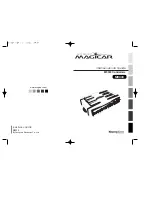
Page 8 of 19
ESP FIREbeam – Installation Manual
2011 Hochiki Europe (UK) Ltd
2-3-0-1340/ISS2/DEC11
2.5 Step 4 - Commissioning
Commissioning the ESP FIREbeam is a simple procedure outlined in the following step by step explanation.
2.5.1
Stage One - Language and Commissioning Speed
IMPORTANT
. Do
NOT
put the reflector up or
COVER
it if already in place.
Power up the unit and you will see
the screen will then default to
or
Access the menu by pressing the
enter
button
The first screen you see is
English
. If you need to change this use the
right
and
left
hand keys to scroll
through languages, when you have found your language press
enter
or if you are happy with English press the
down
key to continue. If you have changed the language the system will continue in your chosen language.
Press
enter
and you will now see the
commissioning speed
screen. In most cases it is recommended to
use
fast
mode (in normal mode the system uses 3.5mA, in fast mode it uses 17mA) - if you are commissioning
more than one beam at a time and the system cannot support the extra draw it may be necessary to use normal
mode to prevent excessive current draw. Fast mode allows x 4 times faster motor response and it may be quicker
to commission each beam in turn. Once commissioning is complete the ESP FIREbeam will automatically revert to
normal low power mode - (3.5mA).
Use the
left
and
right
keys to toggle between fast and normal, the
*
indicates which mode is selected. Press
the
enter
key to continue.
2.5.2
Stage Two - Pre-alignment
The next screen is pre-alignment - this is probably the most important part of setting up your beam. Pre-alignment
sets up the amount of power you need for the distance you are covering and can indicate if you are receiving
unwanted reflections from anything else in the beam path.
Press
enter
to begin pre-alignment. Remember no reflector. You will see the screen below, take a moment to
understand what the figures on the screen mean.
www.acornfiresecurity.com
www.acornfiresecurity.com





































